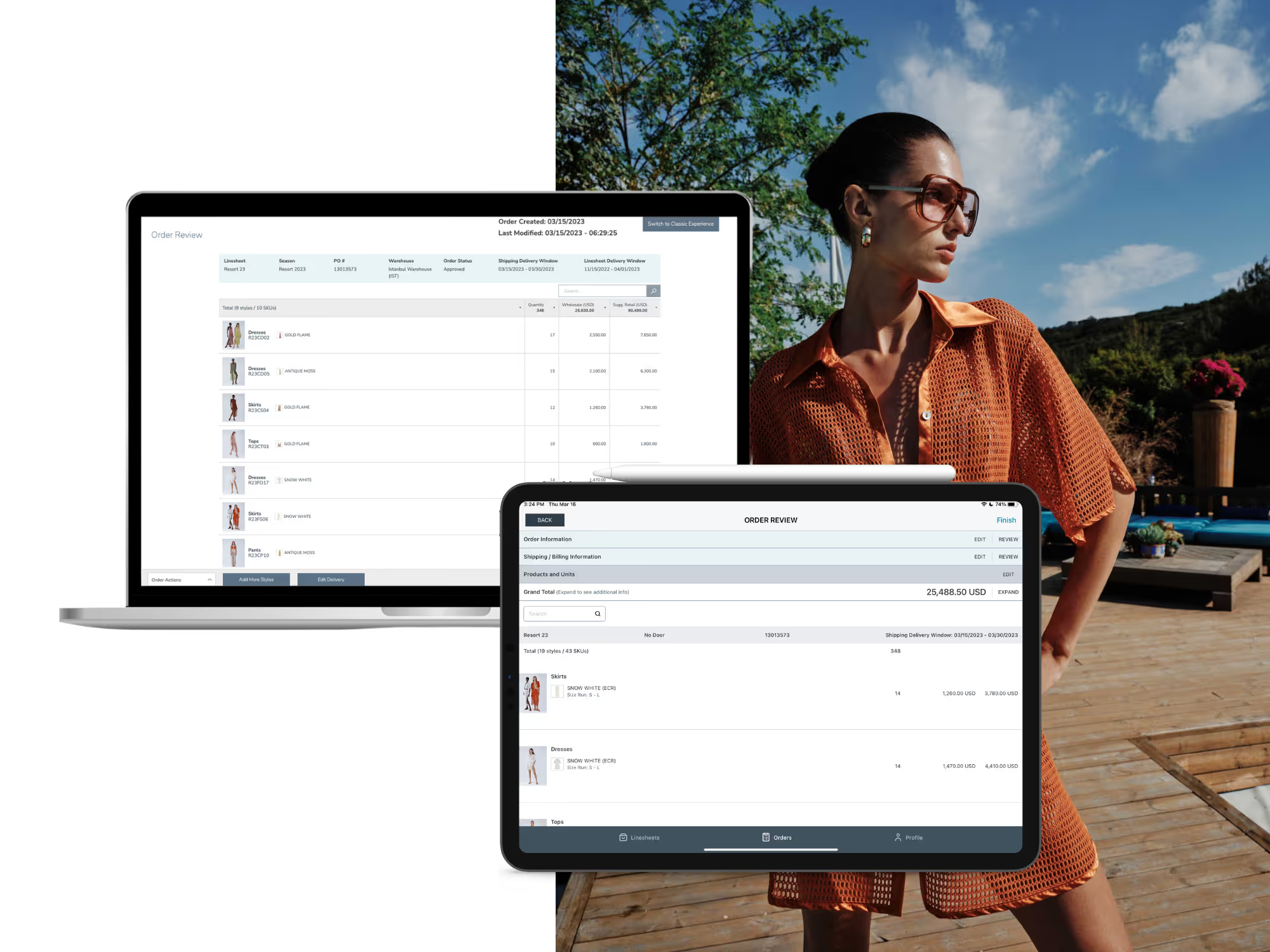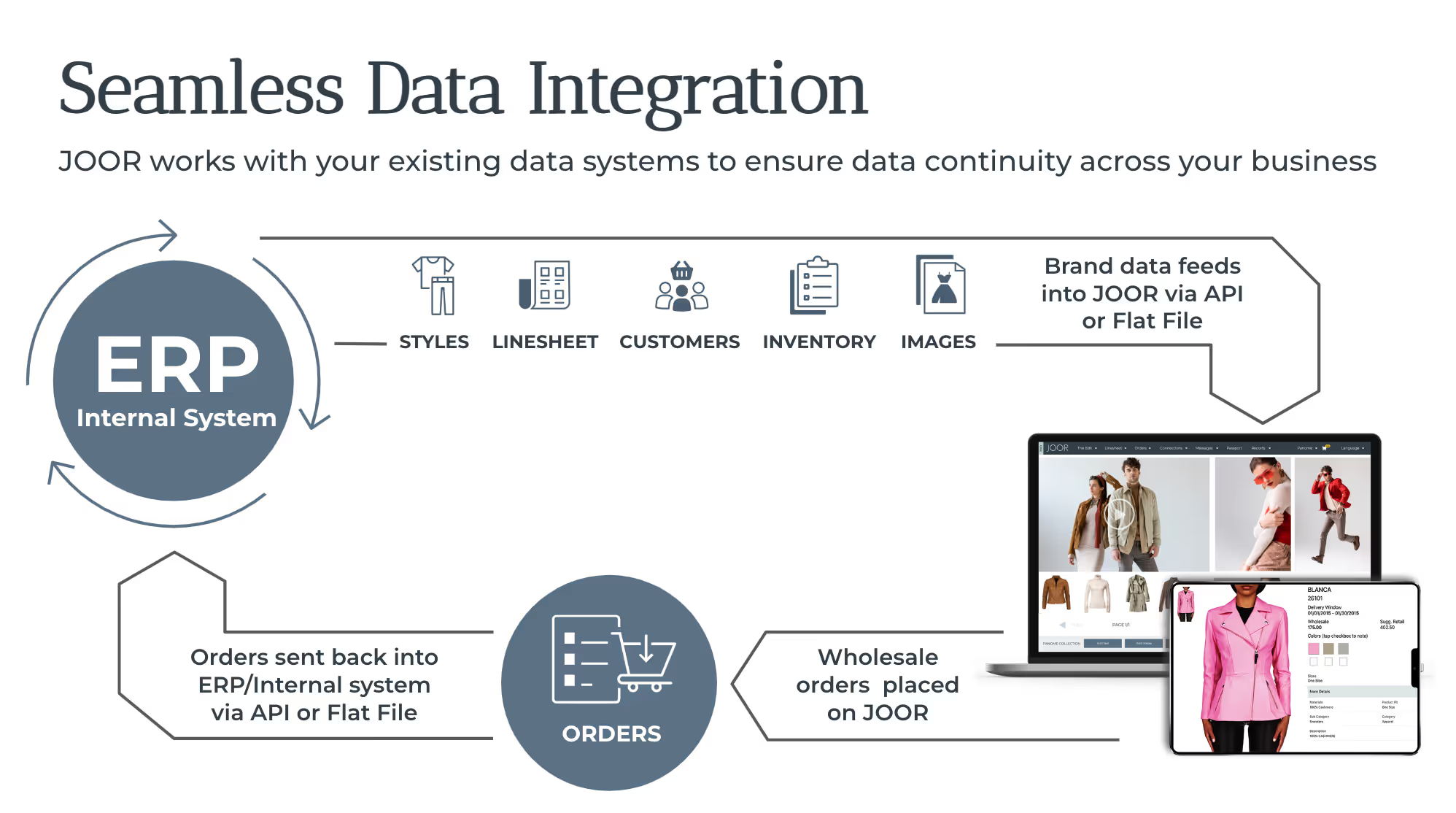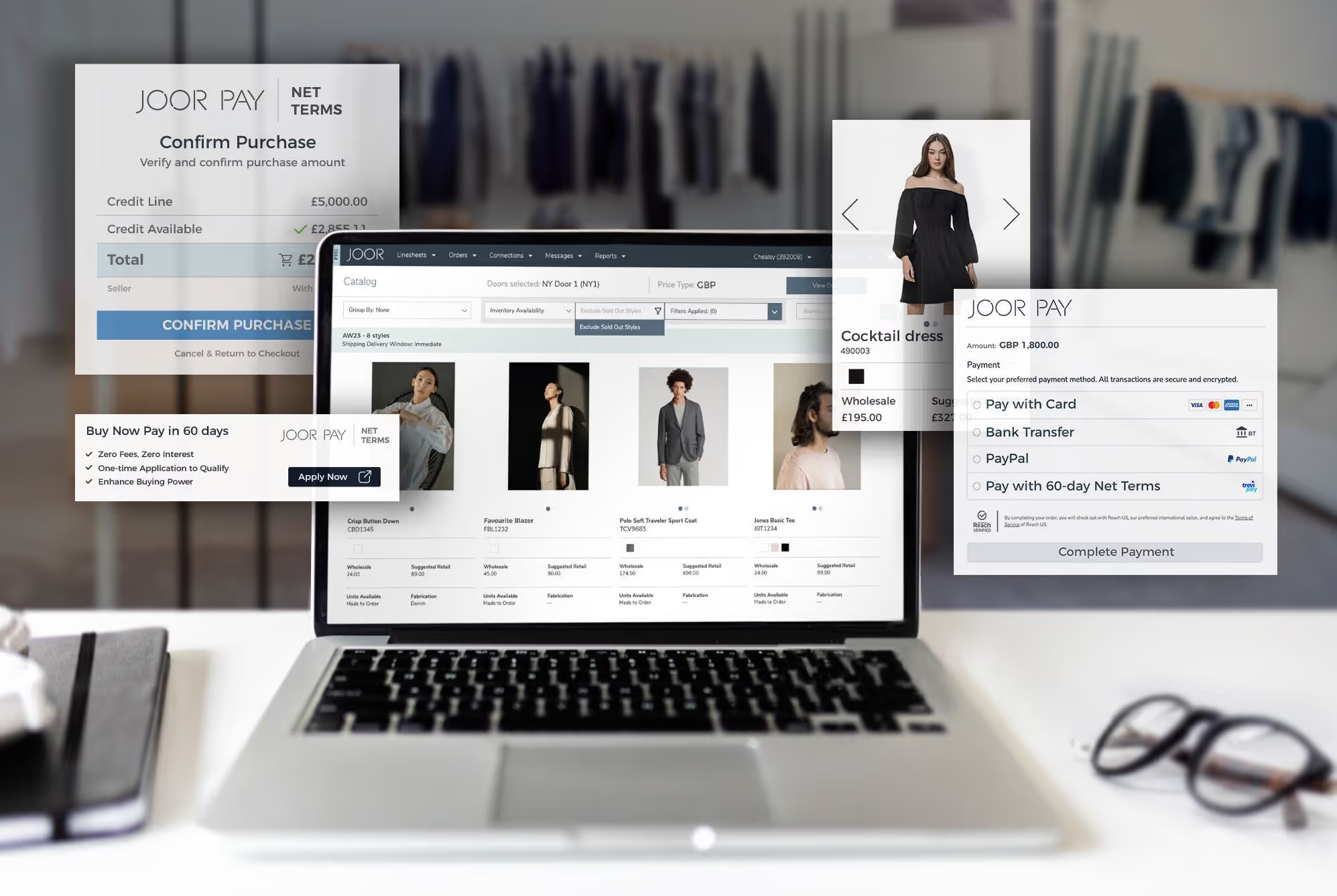How B2B Platforms Improve Fashion Wholesale Supply Chain Management
Discover how JOOR is reshaping the fashion industry's supply chain dynamics. From streamlined ordering and a vast supplier network to improved communication, data analytics, secure transactions, and sustainability initiatives, learn how JOOR offers a comprehensive solution for fashion brands seeking to enhance efficiency.
.avif)
Brief Summary
B2B platforms enhance fashion supply chains by improving data integration, streamlining communication, and providing real-time tracking. These tools reduce manual errors, speed up the process, and offer better collaboration between brands and retailers, ultimately boosting efficiency and service quality.
Key Takeaways:
- Real-time tracking and integrations: B2B platforms provide seamless tracking, ensuring transparency and faster decision-making across supply chains.
- Enhanced communication: Streamlined communication helps eliminate delays, errors, and confusion between brands and retailers.
- Operational efficiency: Automating processes through B2B tools accelerates workflows, reducing lead times and improving overall service quality.
What Is a Fashion Supply Chain?
A supply chain refers to the entire network that supports a fashion business as a garment moves through design and production to distribution and delivery. Every element of the chain is vital to its success, and as these chains are often global, effective communication is essential for them to function properly.
How Wholesale Fashion Is Changing with Digital Platforms
In the ever-evolving world of fashion, staying ahead means not only keeping up with trends but also increasing your agility to be able to adapt to issues like those that exist in supply chain management. The emergence of Business-to-Business (B2B) platforms for fashion wholesale has revolutionized the industry by enhancing operational functions, including those around supply chain.
In this article, we will delve into the world of B2B fashion wholesale management platform, JOOR, and explore how it is reshaping the way fashion businesses manage their supply chains efficiently.
1. Streamlined Ordering and Inventory Management

One of the most impactful ways a B2B platform like JOOR enhances supply chain management is by centralizing and streamlining the entire wholesale ordering process. Traditional methods often rely on fragmented systems, manual data entry, and time-consuming back-and-forth communications—leading to errors, delays, and missed opportunities.
By digitizing orders and integrating real-time inventory visibility, JOOR empowers brands and retailers to collaborate more efficiently, make faster decisions, and respond proactively to market demand.
How it works:
- Efficient Order Placement: The JOOR platform offers retailers a convenient place to browse, shop, and place orders. With intuitive interfaces and easy-to-use systems, buyers can quickly select products, specify quantities, and place orders, reducing the risk of errors associated with more manual processes.
- Real-time Inventory Visibility: Brands can use platforms like JOOR to provide real-time updates on product availability. This allows retailers to make informed buying decisions and more accurately plan their assortment.
2. Access to a Vast Network of Suppliers
B2B platforms increasingly function as dynamic digital fashion marketplaces, offering retailers access to a wide array of brands, categories, and styles all in one place.
This is especially powerful when the platform is built on a network as expansive and curated as JOOR’s. With thousands of premium and emerging brands across 53 product categories, JOOR enables retailers to discover new collections, diversify their assortments, and build meaningful partnerships that drive long-term growth
This network effect is instrumental in enhancing supply chain management:
- Diverse Product Offerings: Retailers can access a wide variety of products from different suppliers, allowing them to diversify their inventory and cater to various customer preferences.
- Reduced Lead Times: Access to multiple suppliers means shorter lead times for product delivery. Retailers can source products from suppliers located closer to their distribution centers, reducing shipping time and costs.
- Price and Quality Comparison: Retailers can easily compare prices and product quality across different suppliers, facilitating informed decision-making.
3. Improved Communication and Collaboration
Effective communication and collaboration are essential to optimizing supply chain performance and building strong wholesale partnerships. Clear, timely, and transparent interactions between brands and retailers help prevent misunderstandings, reduce delays, and ensure everyone stays aligned on orders, deliveries, and product details.
B2B platforms facilitate these aspects in several ways:
- Messaging and Notifications: Built-in messaging systems enable seamless communication between retailers and suppliers. Buyers can inquire about product details, request quotes, and discuss order specifications in real time.
- Order Tracking: Retailers can track the status of their orders, from placement to delivery. This transparency ensures that both parties are aware of the order's progress and can take necessary actions if any issues arise.
- Data Sharing: B2B platforms allow for the sharing of essential supply chain data, such as inventory levels, sales forecasts, and order histories. This shared information helps suppliers plan production and inventory management more efficiently.
4. Data Analytics for Better Planning and Decision-Making

Data has become one of the most valuable assets in modern supply chain management, empowering brands and retailers to make informed decisions that drive efficiency and growth. B2B platforms like JOOR harness the power of seamless data flow by aggregating real-time insights across ordering, inventory, and customer behavior.
How B2B platforms optimize operations:
- Sales and Inventory Analytics: Retailers can access detailed sales and inventory reports, enabling data-driven decision making. This data can reveal sales trends, identify slow-moving items, and assist in inventory planning.
- Demand Forecasting: Advanced analytics tools can analyze historical sales data and market trends to generate accurate demand forecasts. This allows suppliers to proactively adjust production and inventory levels to meet future demand.
- Supplier Performance Metrics: Retailers can evaluate the performance of different brands based on key metrics such as on-time delivery, product quality, and order accuracy. This information helps in supplier selection.
5. Secure Transactions and Payment Processing

B2B platforms prioritize security in financial transactions, reducing the risk of payment disputes and fraud. JOOR’s embedded checkout solution, JOOR Pay, is designed to simplify and expedite the payment collections process.
JOOR Pay improves transactions with:
- Improved Cash Flow: Brands can eliminate time wasted manually chasing payments and reduce time from invoice to payment 30 days on average.
- Secure Payments: JOOR Pay reduces the risk associated with handling sensitive payment information by acting as the merchant of record.
- Payment Terms and Invoicing: Retailers and suppliers can agree on payment terms, such as net-30 or net-60, and automate the invoicing process. This ensures timely payments and reduces administrative overhead.
- Increased Flexibility: With JOOR Pay, brands can send invoices and collect payment, whether or not they finalize their orders on the JOOR platform.
6. Sustainability and Eco-Friendly Practices
Sustainability is an increasingly critical priority in the fashion industry, as brands and retailers alike face mounting pressure to reduce their environmental impact and embrace more responsible business practices.
B2B platforms help promote eco-friendly practices in the supply chain by:
- Sustainability Metrics: B2B platforms can include sustainability metrics and certifications for products, allowing retailers to make environmentally conscious choices when sourcing products.
- Reduced Waste: By leveraging the suite of B2B platform tools, brands and buyers can help reduce carbon emissions associated with travel to and from market appointments, and cut down on waste associated with manual processes such as printed linesheets.
7. Seamless Integration with ERP, POS & Accounting Systems
B2B platforms help fashion brands digitize their processes and integrate different areas of business for a faster and more efficient supply chain. By allowing different departments to communicate with each other easily, these tools reduce errors and improve transparency across the entire process.
JOOR streamlines supply chain processes with:
- 100+ ERPs: as well as a wide range of POS and PLM integrations, to provide a streamlined flow of wholesale order data to your existing systems.
8. Faster Time-to-Market & Seasonal Agility
To reduce the amount of time it takes to bring a product to market, brands can use B2B platforms to reduce their manual processes, digitizing daily tasks and streamlining communication.
B2B platforms aid seasonal agility using:
- Real-time inventory updates: automated product syncing gives you a better overall view of your business, allowing you to make smarter and faster business decisions
- Virtual showrooms: open 24/7, these spaces allow for flexible reordering for buyers, whenever they need them.
The Future of Fashion Supply Chain: AI, Automation & Connected Ecosystems
The Future of Fashion Supply Chain: AI, Automation & Connected Ecosystems
As technology advances, AI is set to play an increasingly pivotal role in the fashion wholesale supply chain. Today, brands are already leveraging AI for design, automated logistics, and product traceability through digital passports.
Looking ahead, we expect B2B platforms to adopt AI for smarter brand-buyer matchmaking, hyper-personalized assortment planning, and even automated tariff classification, driving greater efficiency, resilience, and cost-effectiveness across global operations.
B2B Platforms in Wholesale Fashion
B2B platforms for fashion wholesale are transforming the way supply chains are managed in the industry. From streamlined ordering and inventory management to access to a vast network of suppliers, improved communication and collaboration, data analytics, secure transactions, and sustainability initiatives, these platforms offer a comprehensive solution for fashion brands seeking to enhance their supply chain efficiency.
As technology continues to advance and the industry evolves, B2B platforms like JOOR will remain a crucial tool for fashion professionals looking to stay competitive and adapt to changing market dynamics. Embracing these platforms is not just a trend; it's a strategic decision that can reshape the future of fashion supply chains.
Learn more about our platform, request a demo today.
FAQs: Fashion Supply Chain
What are the main stages of the fashion supply chain?
A fashion supply chain takes a product through the following stages: design, sourcing, production, distribution, and retail.
How do B2B platforms help fashion brands?
B2B platforms help brands digitize and automate areas of their wholesale operations for more streamlined processes, making their supply chain run more efficiently and allowing different areas of their business to communicate with each other more easily.
Why do fashion supply chains face delays?
Supply chain delays can occur due to several reasons, including transportation issues, labor shortages, geopolitical issues, or, most commonly, a lack of visibility, making it difficult for brands to react to potential disruptions in time.
How does inventory management affect profits?
Holding too much stock ties up capital within inventory, stopping a brand from investing money in other areas of business. Holding too little can lead to stockouts and supply chain issues. Both negatively affect profits.
Can B2B platforms improve sustainability?
B2B platforms help brands improve their sustainability efforts by digitizing processes to reduce reliance on pen and paper, providing tools like virtual showrooms and digital trade shows to reduce the need for international travel, and allowing better supply chain transparency, so brands can easily identify areas for improvement.
Related Insights

Why Digital B2B Catalogs are Essential for E-Commerce Businesses
Online catalogs have become a crucial component for retailers and their buyers in an evermore tech reliant industry. Read about how these dynamic product libraries act as comprehensive selling solutions that plug into current buying behaviors.
%2520(2)%2520(1).avif)
8 Ways a B2B Fashion Marketplace Solves Wholesale Scaling Challenges
Learn how a B2B fashion marketplace like JOOR helps your wholesale fashion brand overcome scaling challenges. Maximize resources, build retailer relationships, and enhance distribution to drive growth in the global wholesale fashion market.
%2520(1).avif)
Price Sheets Vs Line Sheets in Wholesale Fashion
Explore the key differences between price sheets and line sheets in wholesale fashion. Optimize product showcasing and sales strategies with clear pricing details and captivating visuals. Enhance buyer experience and streamline ordering process effectively.


